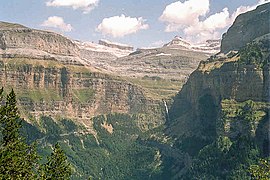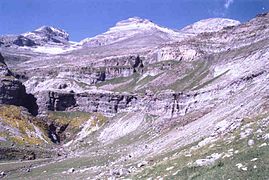Ordesa Valley
The Ordesa Valley is located in the central Pyrenees of Huesca, Sobrarbe region, Aragon (Spain). It is listed as a World Heritage Site by Unesco.
This valley originated the creation of the Ordesa National Park on August 16, 1918. Years later, in 1982, it would be expanded to create the Ordesa y Monte Perdido National Park including the Monte Perdido massif, the Añisclo Canyon, the Escuaín Gorges and the head of the Pineta Valley.
In a broad sense, the Ordesa Valley comprises a wide area of small valleys and ravines, plateaus and peaks (many over 3000 m high), whose limits would be the Monte Perdido-Mondarruego ridge to the north, which serves as a much of the border with France, to the south the Sierra Custodia-Acuta ridge and to the west the confluence with the headwaters of Valle del Ara or Bujaruelo valley. All this set forms a fluvial basin, which through secondary valleys and waterfalls, flows into the Ordesa Valley itself, through whose bottom the Arazas river runs. The source of this river occurs in the Ordesa Valley through the water that falls from the peaks, forming the Cola de Caballo waterfall, which is very famous in the valley for being the final goal of the hiking route that bears its name.
High areas
In the high areas, a part of the North crest stands out, from Monte Perdido (3355 m) to Gabietos (3034 m), a whole succession of peaks over 3000 m and in which an impressive crack opens, the "Rolando Gap", a "natural" passage between France and Spain and which according to legend was opened by a blow from Rolando's sword (how else to explain such a phenomenon of nature). Slightly south of the breach is the Casteret Grotto, the interior of which is largely frozen, with columns and icefalls. It is currently closed to the public, and a permit from the park is required to enter.
The northern slope descends in a succession of cirques and glacial valleys, with impressive waterfalls, among which the Cotatuero Circus and waterfall stand out, along the route of which are the famous "Cotatuero pegs", simple metal bars stuck on a vertical wall with a forced passage and not suitable for people who suffer from vertigo...
Access to the peaks of the Ordesa Valley can be done by vehicle from Torla (Huesca) through a forest track, although access is restricted to authorized vehicles.
Low areas
The Ordesa Valley itself is a spectacular glacial valley, with a marked "U" shape, located to the southwest of the Monte Perdido Massif, at the bottom of which the Arazas River descends in a succession of beautiful waterfalls. From the one that begins the valley, in the Circo de Soaso, known as the "Cola de Caballo", and which opens in a white fan that slides down the rock, passing through the Gradas de Soaso, a succession of multiple stepped waterfalls, to the waterfalls of the Strait and the Cave, huge waterfalls that have carved zigzagging slides in the limestone rock.
In the vertical walls of the valley, produced by the different hardness of the rocky layers exposed by the action of the old glacier, several "strips" open up, small horizontal cornices that allow you to cross the valley in height through vertiginous and narrow paths. Among them, the Senda de Cazadores stands out, which reaches a 600 m drop in level with respect to the bottom and allows practically the entire valley to be seen from a bird's eye view along its southern slope, and the Faja de las Flores, higher and more vertiginous in the north slope.
Flora and vegetation
The first works on the flora of the Ordesa Valley were carried out by Taurino Mariano Losa and Pedro Montserrat Recoder in 1946.
Image gallery
Contenido relacionado
Annex: Place names of Morocco
Stockholm
Barbalos











